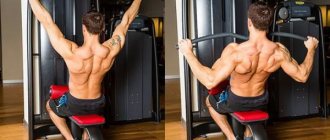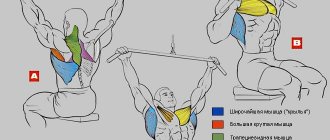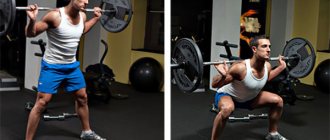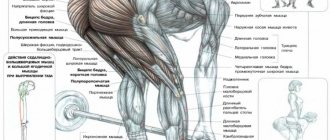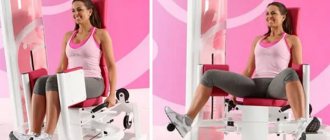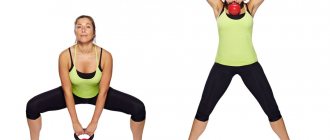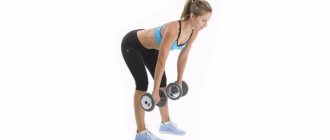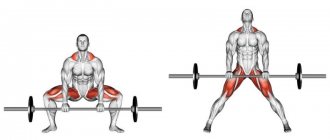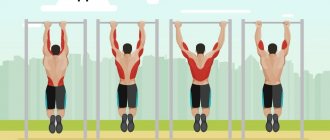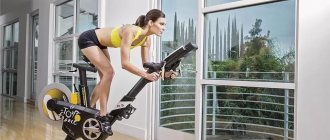To achieve a beautiful, stately and pumped up figure, most people regularly exercise. They visit training rooms, which are equipped with all kinds of equipment and equipment. Each fitness room has in its arsenal an “upper block” exercise machine. The exercises performed on it help to perfectly pump and comprehensively develop the back muscles. To do this, it is necessary to perform various types of thrusts from the bottom up. The lat pulldown is a basic exercise that is done behind the head, to the chest, to the lower back, and so on.
Description and features of the exercise
To pump up the back muscles, the athlete is required to concentrate and comply with the rules and regulations regarding the technique. In a block machine, vertical rows resemble regular pull-ups. The main anatomy is that at the time of execution, the biceps and the main muscle group - the broad back muscles - are involved. Therefore, it is important to perform deadlifts accurately and correctly, since this exercise is the best way to strengthen and maintain the muscular parts of the back.
Physical fitness, especially muscle development, must remain at the proper level, since exercise is characterized by the addition of weights. In this case, the mass of additional equipment can significantly exceed the person’s own body weight.
What muscles are involved?
In addition to the “wings” of the back, lat pulldowns additionally load the muscles:
- torso – abdominal and erector discs of the vertebrae;
- forearms and shoulder rotators;
- diamond-shaped, jagged anterior, lower and middle trapezoidal;
- wrist flexors, biceps.
The simulator includes different types of bars. The muscle groups of the shoulder girdle, which take on the secondary load, change significantly depending on the width of the grip and its type. To pump up the back muscles, especially the broad muscles, the biceps should take on a minimal part of the load during the exercise.
The chest row activates the abdominal muscles of the trunk - stabilizers, if you perform small, as light as possible bends back without introducing a large load mass.
One-arm vertical row using the trapezius and head of the biceps muscles strengthens the anterior and middle part of the deltoid muscles, the clavicular part of the pectoral muscle.
Benefits of doing it
Vertical rows do not require much time from the athlete and provide a number of benefits:
- beautiful back muscles;
- narrow waist and straight posture;
- the torso becomes V-shaped when viewed in profile;
- availability of execution in any gym or fitness room.
The lat pull-down is one of the simplest and most popular exercises in training, as the back muscles grow very quickly. That is why novice athletes perform this exercise as often as possible and with a large number of approaches. Pulls to the chest in parallel, with one grip, behind the head and others allow you to work your back in different planes and angles.
How is it different from pull-ups?
The block simulator, on which vertical rows are performed, is a direct analogue of the horizontal bar for simple pull-ups. Meanwhile, during the usual, well-known pull-ups, the main load involves the biceps, and the back works only 25-50%. The pull of a vertical block to the chest works exactly the opposite: the main load goes to the top, allowing you to pump the latissimus muscles of the dorsal region.
This exercise is also different in that the overhead row is performed while sitting. In this case, the projectile is pulled towards the body, and not the body towards the crossbar (projectile). Thanks to the block design with a seat, the exercises can be performed by people for whom pull-ups on bars are strictly contraindicated and those who do not know how to do pull-ups.
The ability to use different bars and additional weight (from 2 kg) is another significant difference from conventional pull-ups.
Why exercise for girls?
Depending on the goal and load, women can work on mass or exercise to “dry”, strengthen and pump the upper back and shoulder girdle. Using different variations (vertical row with a medium, straight, narrow or wide grip) allows girls to:
- master the correct pull-up technique;
- pump up the muscles of the arms and neck;
- strengthen the cervical vertebra;
- achieve a perfect V-shaped torso and narrow waist.
Who is contraindicated for
The lat pulldown has few contraindications. Block exercise machines can be found even in rehabilitation centers, where doctors strongly recommend performing this exercise. Caution should be exercised if the thoracic vertebra contains a hernia.
Vertical rows performed with one arm are not recommended if the shoulder girdle cannot or is not ready to make sudden amplitude movements. The exercise is strictly prohibited in case of severe elbow injuries, as well as in case of damage to the hands and shoulder muscles, since during the exercise there is a load on the shoulders.
Main muscles involved
TVB has long been recognized by all trainers as one of the most basic exercises.
It is suitable for beginners or already experienced athletes, since it is a combined and multi-joint technique. When performing it, the elbow and shoulder joints are involved, and the load is directed to the back muscles. In accordance with this, TVB is recognized as indispensable for working out the “wings” - the latissimus dorsi, teres major and pectoralis major muscles. In addition, when performing this movement, the biceps, the back of the deltoid muscle, the rhomboid and brachial muscles are also included in the work. The triceps are also pumped up a little. Working out the muscles will depend on the grip with which the athlete holds the bar of the block machine. The structure of the figure also depends on the chosen type of grip - using all types of TVB, you can strengthen the listed muscles of the back and shoulders.
Execution technique
To pump up your back muscles, you need to do lat pull-downs correctly. Each grip has its own characteristics.
However, one type or another begins with the preparation of the simulator.
To do this you need:
- select and install weights up to 15 kg (a large weight will lift the torso up, which should not happen);
- adjust the seat (your legs should fit snugly between the bolsters and the seat).
Narrow grip
Overhead rows work the biceps and to some extent the forearms.
The exercise technique includes 7 sequential actions:
- Stand up and with your hands, at a distance of 10 to 15 cm, take the handle.
- Sit down and feel the set weight by pulling the vertical block.
- Using the strength of the back muscles (without tension on the biceps), pull the elbow down until the bar is pulled to the bottom of the chin.
- Raise your head a little up so that it does not interfere with the moving weight and its trajectory.
- Pull the handle down (strictly vertically) to your neck, lowering the weight to your chest.
- Hold the weight for a few seconds.
- Return to original state.
The lat pulldown with a narrow grip is performed while sitting, without lifting the pelvic part of the body and tilting the back back.
Wide grip
Using a wide grip, pull the upper block towards the chest and behind the head. For both variations, as with the narrow grip, you must prepare the equipment.
A wide vertical (upper) row allows you to activate the work of the spinal muscles. At the same time, the biceps and muscle groups of the forearm, when performing a straight wide grip to the chest, are activated to a minimum.
Recommendations for effective implementation
The technique of execution necessarily requires a clear sense of which part of the body bears the bulk of the load and is working at its maximum.
To perform “for results” you need to know:
- how to place your elbows correctly;
- how to work with your back;
- how to choose working weights;
- when to increase muscle contractions.
Working with your back
Sometimes the top block is performed incorrectly. That is, the main loaded pull is received by the biceps, and the rest of the weight is supplied by the latissimus muscles. In this case, the biceps get tired, and the pull-down does not strengthen or expand the back.
The upper row of the block is intended strictly for the comprehensive development of the spinal muscle groups! This is what the vertical row, performed with a wide grip, focuses on. Therefore, when the weight is pulled easily, it’s worth stopping for a split second and feeling how exactly the exercise is being done - biceps or “wings”.
How to place elbows
Rows performed while seated require different placement of the arms. The position of the elbows decides which parts of the back muscles work more. Elbows should not move back and forth. They need to be recorded. Shoulders should be at the same level.
During the exercise, the palms of your hands can be directed both towards you and away from you:
- biceps involvement increases significantly if the palm is facing towards you;
- The pectoral muscles actively work when using a parallel handle, when the palms are facing each other (seated chest pull).
Cheating
Most athletes doing shoulder exercises for their back risk straining or injuring ligaments by bringing down a heavy handle with their full weight. After all, rowing with a wide grip in a vertical block additionally engages the deltoid muscles. Their bundles must be warmed up before starting an intensive workout, that is, do a warm-up.
Without pre-warmed muscles, pulling to the chest from the upper block can have a detrimental effect on the health of the elbows and their joints. The “wings” are difficult to pull, but the shoulders are a mere trifle.
Selecting the working weight
The pull of a vertical block behind the head or to the chest is done while sitting, and implies the presence of additional weights. If jerky jerks occur during exercise, then you need to change the weight to a lighter one and check how accurately and comfortably the seat is installed. Then the block pull will be performed smoothly to the chest, without jolts.
Trainers recommend starting with light weight (from 2 kg). This approach will allow you to feel the back muscles and perform the exercise correctly 15-20 times.
We increase the quality of muscle contractions
A vertical row, for example, performed with one arm, uses one forearm and hand of that arm. To achieve better contraction without fatigue of the biceps and brachialis muscles, you need to use special loops (belts for hands). Similarly, you can neutralize the load on your arms and improve the quality of muscle contractions in your back by holding the handle with a reverse grip.
Execution options
The work of certain muscles depends on the width and angle of the direction of the grip. Knowing the features and subtleties of each exercise technique, you can, together with the trainer, create the correct sequence of classes. This approach will not leave any area of the back unattended.
Standard rods include different options in their arsenal, which differ slightly from each other. In this case, the exercises allow you to work out one or another part of the back.
To the chest with an overhand grip
Straight-grip rows of the upper block to the chest while sitting are a classic execution, performed with a medium or wide grip.
Execution sequence:
- Grasp the bar with both hands. Turn the inside of your arms (palms) forward.
- Bend your lower back, tilt your head 15-20 cm back.
- Using the strength of your back muscles (wings), pull the weight up or down your chest.
The pull of the upper block is performed strictly vertically down in front of you, with the body tilted slightly back. Otherwise, it will be impossible to achieve the desired angular position to increase muscle mass.
Per head
The vertical wide overhead row allows you to feel literally all the latissimus muscles. That is why this traction option is suitable for beginners. After all, initially the back is trained, and then it is “pumped up”.
The exercise technique is simple:
- Place and fix the palms of your hands at the bend of the handle.
- Tilt your head down (literally 5 cm maximum).
- Without bending your body, pull the weight up to your neck, with the bar behind your head.
- Fix the weight on the upper block (literally for 1-2 seconds) and return to the starting position.
The pull should not go all the way to the chest. You should also not push your elbows back behind your back. Actions must take place with a perfectly straight torso.
Parallel grip
Parallel overhead pull-down in a block to the chest with a wide grip received a second name - neutral pull-down of a vertical block towards yourself. The only difference from other types of traction is that stronger loads are applied. For parallel traction of the upper block, the simulator must be equipped with special handles to make it easier to hold onto the handle when working with a large, serious mass of weights.
Reverse grip to chest
Pulling a block with a reverse grip to the chest pumps the lower part of the wings and implies an almost similar sequence of actions:
- Place your hands on the bar slightly wider than shoulder width.
- Sit down, leaning back so that your torso is counterweight to the cable on the exercise machine.
- Perform a press by pulling the weight down (elbows should be at a 45-degree angle).
- Pull the vertical bar of the exercise machine towards your chest.
Parallel grip lat pulldown is a simplified version of the regular chest row.
The vertical pull-down is a basic exercise that simulates pull-ups. Therefore, it is important to perform it to strengthen the back muscles. Naturally, working on the horizontal bar without weights, the athlete will achieve little. In order for muscle growth (hypertrophy) to occur, good progressive loads are needed.
The lat pulldown allows you to use weights that exceed your own body weight. At the same time, there is no danger of falling down and falling - after all, you are sitting. Block traction is very important, and now you know why.
Working muscles
This exercise stretches the lats very well and works them well. At the bottom point, bend, meeting the handle with your chest, at the top point, lean forward a little. This will enhance the effect of this exercise.
Main features
1. This type of traction, firstly, is quite comfortable, and it can be done by people with any degree of mobility in the joints. And secondly, it works better on the central part of the back. Including not only the latissimus muscles, but also the teres and infraspinatus muscles.
2. At the lowest point, you need to arch your back, squeeze your shoulder blades together and push your chest up. As if I meet the handle with my chest. And at the top point, it is advisable to move the body forward in order to better stretch the muscles.
3. If you don’t know how to do pull-ups, this exercise will help you learn faster. Because it imitates pull-ups. The weight should be such that you can do at least 8 repetitions.
4. Alternatively, you can do rows with a wide parallel grip. For this you need a special pen. With this option, the load will be distributed more on the outer bundles of the latissimus muscles.
5. Try not to spread your elbows to the sides, but press them closer to your body. This will increase the efficiency of the exercise.
Common mistakes
In a block simulator, vertical rows require maximum concentration and the correct sequence of actions.
Often, beginning athletes make the following group of mistakes:
- curvature, stooping of the vertebra;
- incorrect elbow position;
- the movement occurs with the buttocks lifting off the seat;
- when pulling the bar, the forearms are fully extended;
- the load is distributed on the biceps and other parts of the muscles, and not on the main body (back muscles);
- too much weight is taken, so the exercise becomes difficult to perform;
- vertical row, performed behind the head or with one hand, without warming up or preliminary preparation.
The above mistakes can be avoided if you approach your studies correctly. After all, there are no quick results!
Basic mistakes and recommendations
Like other types of deadlifts and presses performed on block machines, TVB is distinguished by nuances in its technique, without which it will not be possible to properly work the muscles. However, many beginners make technical mistakes, among which the most common are the following:
- TVB due to inertia. Many beginners pull weights using the energy of inertia, leaning their body away from the machine and pulling the bar to the top of their back with a jerk. Such incorrect technique can injure joints and greatly reduce the effectiveness of training.
- TVB due to arm strength. Often an athlete takes on most of the load during a TVB exercise at the expense of the strength of other muscles, but it simply doesn’t make sense to train this way. To eliminate the error, you need to carefully monitor the location of your elbows.
- TVB using your own weight. Some beginners pull a weighted block using their own body weight, giving the force an initial acceleration. This practice leads to injury and is ineffective.
So, TVB is the main exercise that helps increase back muscles. But for muscle growth to progress, you need to constantly increase the load and comply with the correct technique.
Recommendations from professionals
- the weight should be pulled with your back, not with your hands;
- it is necessary to ensure that the handle is in a strictly fixed position;
- You cannot “walk” your elbows up and move them to the sides;
- there is no need to tilt the body too much if the work is carried out with light weight;
- when working with heavy weights, use straps to make it easier to hold the bar;
- The bar bar must be pulled as close as possible and strictly to the top of the pectoral muscles;
- looking down and tilting your head is strictly prohibited;
- select the weight so that there are no jerks;
- you can’t slouch;
- at the lowest point, pause for 1-2 seconds, tense your abs and legs, without lifting them from the clamp on the simulator.
Perform any of the exercises in 2, maximum 4 approaches. In this case, it is better to have 10-12 repetitions.
